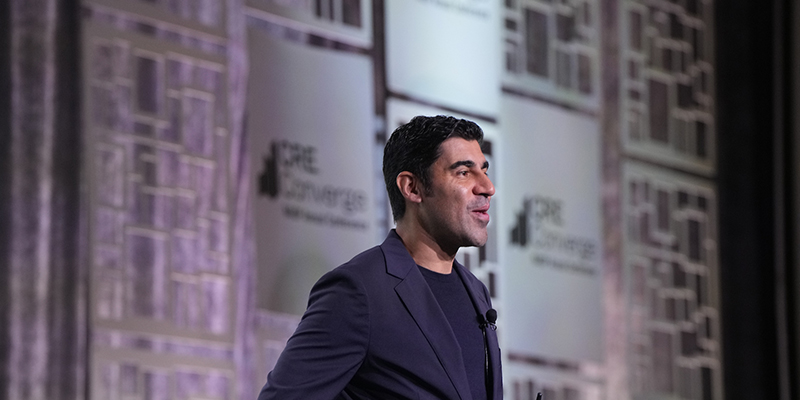By Kathryn Hamilton, CAE
At NAIOP’s I.CON East conference last week in New Jersey, former U.S. Secretary of Commerce Gina Raimondo delivered a candid assessment of the U.S. economy: strong at its core but held back by what she called “self-inflicted wounds.” Despite global leadership in innovation and artificial intelligence, and a resilient tech sector, she warned that uncertainty, policy inconsistency, and trade disruptions are clouding near-term growth.
Still, Raimondo struck an optimistic note about the future of American industry, pointing to the semiconductor sector as a critical engine for economic expansion – and a powerful example of how strategic investment can help reshape the nation’s industrial future.
“We ought to be rocking and rolling,” she said, adding that long-term prospects for the economy are solid but warned that the near term will likely be a different story.
Raimondo sees the industrial sector – particularly advanced manufacturing – as a major growth area over the next decade. Raimondo pointed to semiconductors as a prime example, citing the landmark $7 billion Intel project in Columbus, Ohio. As Secretary of Commerce, she helped drive the passage of the CHIPS and Science Act, aimed at revitalizing domestic semiconductor production and reducing America’s reliance on foreign manufacturing.
The U.S., she reminded the audience, invented semiconductors – the very reason “Silicon Valley” got its name. But over the last several decades, production moved overseas, noting that U.S. at one time produced 40% of the global chip supply. Now just 10% are made in the U.S. – with none of leading-edge chips that are solely made by one company in Taiwan. The CHIPS Act, and the broader industrial policy it represents, is now reversing that trend. Major chip clusters are expected to develop in Texas, Arizona, upstate New York and Ohio. As primary manufacturing returns so too will an ecosystem of suppliers and supporting infrastructure – a boon for developers and logistics operators.
Raimondo forecasts a massive amount of semiconductor manufacturing development in the U.S. over the next decade – and along with it comes ripple effect that will require new facilities, more suppliers, and increased demand for well-located industrial real estate.
She says she encourages business leaders to rethink their sourcing and manufacturing strategies, moving critical production closer to home or establishing redundancy in regions outside China and Taiwan.
“We are overly dependent on China for pharmaceutical inputs, ingredients and complete products,” Raimondo said. “It’s dangerous from a national security perspective, and we can create jobs here.”
She pointed to a structural gap in the U.S. pharmaceutical supply chain: the lack of mid-sized, scalable manufacturing facilities. “If you’re a startup biotech, you can do your bench science here, you can do small batches. But when it’s time to scale a little, you go to China. The facilities just don’t exist here in the U.S.,” she explained. “We need to rethink that and bring some of that capability back.”
Access to power is rapidly becoming the make-or-break variable. “Amazon, Google, Microsoft, OpenAI – they’re all desperate for power. They’re sending teams to scour the country – and the world – for affordable, clean, plentiful electricity. It’s not just about price anymore. It’s about long-term access and stability”
Beyond power, she named permitting speed and available workforce as two other critical considerations. “Permitting is still a huge issue. If a jurisdiction can say yes quickly and cut through red tape, it has a major advantage. Developers like you know how painful delays can be,” she said.
Artificial intelligence (AI), she said, is both an opportunity and a wild card. It will demand vast amounts of electricity and require a new generation of data centers, but the labor implications are concerning. She noted that some CEOs today have projected shedding 20-40% of their workforce thanks to AI-driven efficiencies. That’s deeply concerning – not just economically, but socially, she said, and retraining the workforce to meet the demands of new industries is a massive yet necessary undertaking.
When asked about the current administration’s indication it may move away from multilateral AI guardrails, she was unequivocal. “I think it’s dangerous. America is at its strongest when it works with other countries. AI is ubiquitous, and if powerful models or chips fall into the wrong hands, we could face threats ranging from bioterrorism to cyberattacks.”
Raimondo was optimistic about the benefits that come from public-private collaboration, noting that the CHIPS Act aimed to attract $10 in private investment for every $1 in public funding – and exceeded expectations with a 12-to-1 ratio. But, she said, these examples are still too rare.
In response to growing concerns about China’s technological ambitions and intellectual property practices, she emphasized a two-pronged strategy: protect U.S. advantages while accelerating innovation.
She expressed concern over recent proposals to cut research and development and reduce access to high-skill immigration. This spring, China announced a $140 billion venture fund to invest in deep technology and while Raimondo says the U.S. is still ahead, the country must stay that way by out-innovating the competition.
Raimondo ended with an emphatic endorsement of American economic strength and opportunity.
“I would rather be living or running a business in the U.S. than anywhere else in the world,” she said. “We have the best talent, the best universities, the deepest capital markets. We have a democracy that functions. We’re not perfect, but we’re strong.”
“So, be cautious. But also be confident. Never bet against America.”
Read part one of the coverage surrounding former U.S. Secretary for Commerce Gina Raimondo’s I.CON East remarks on the Market Share blog.

This post is brought to you by JLL, the social media and conference blog sponsor of NAIOP’s I.CON East 2025. Learn more about JLL at www.us.jll.com or www.jll.ca.







